Taven Moore's Blog, page 21
June 30, 2014
UX – Screen Size Breakpoints
I think I’ll be tagging all of my UI/UX posts with UX in the title, just for simplicity’s sake. That way, you can skip them if you’re not interested.
So! Screen size breakpoints. What are they and why do we care?
Interactive Fun Times!
To see screen size breakpoints in action, you can use this site! Visit tavenmoore.com from a desktop computer with a pretty good size monitor on it. Make sure the browser is resizeable, then snag one of the sides and slowly begin shrinking the width of your browser.
See how things start to shift around to better encompass the space?
Every time the content LEAPS to a new configuration, that’s the code hitting a new breakpoint and changing what CSS your browser is rendering.
I’m not 100% happy with everything about this theme’s handling of the smallest breakpoints, but it’s definitely good enough for now and it’s a great example of what I’m talking about here.
Extra fun points? Doing this on other sites around the internet and seeing which ones are using break points.
Designing for multiple screens
Back in the day, pretty much every website was designed around the assumption that 99% of the userbase had about the same size monitor at about the same screen resolution. 800×600. Anyone remember those days?
Then, disaster struck! cue dramatic lightning strike About the year 2000, people started buying BETTER monitors. With higher resolution and more screen real estate.
Design retaliated by sticking their fingers in their ears for as long as they could, then very grumpily redesigning websites to fit a primarily 1064×768 resolution — typically restricting the majority of the website content space into a 1000 pixel “stream” down the center of the page.
And if you had 800×600 resolution, you just had to deal with it, because we designers are too busy to create tons of versions of our sites for you.
Ah, I remember those days.
The tide is turning. HAS turned, for most companies. We’re not dealing with a battle between two screen resolutions anymore. We’re fighting an epic WAR between screen resolution, browser versions, mobile phones, tablets — it’s DANGEROUS out there, and trying to design for all of them is a nightmare.
(Though pretty much every designer agrees that Internet Explorer is the One True Villain in all of this, as NOTHING fun ever works in IE and folks who use IE are notorious for never updating. Which is not entirely their fault, because Windows has been historically horrifically expensive to update, but that’s another post entirely)
Some sites are still doing the fingers-in-ear routine. These are the ones you have to painfully pinch and zoom when browsing via your phone.
The moment you realize your world has turned into “does this site look nice on a Kindle fire turned horizontally using the Safari app AND a Windows phone held vertically?” you realize you need some standards.
Enter the handy-dandy Breakpoints system.
Screen Size Breakpoints
The industry has more-or-less decided to agree upon a series of screen sizes as “breakpoints” — significant changes in screen size which kinda-sorta represent different devices folks might be using.
Many designers are using media queries in CSS to hide/show/move various blocks of the website around so that they look different for the various screen sizes.
Twitter Bootstrap (a very popular design platform, and you needn’t know more than that for the moment) has simplified these media queries to the easy-to-understand XL (wide, big screens) L (normal size screens) M (small computers or very large tablets) S (tablets and really big phones) and XS (most phones).
TLDR : Too Long, Didn’t Read
In other words, instead of having to worry about EVERY SCREEN RESOLUTION EVER, designers try to make things look good in about five different sizes.
Discussion Time!
I mostly wrote this post so I could talk to you all about the heated debate over the use of the hamburger icon, but I figured it was an important enough building-block topic to be worth its own post.
Tell me — have any of you tangled with sites that were inflexible and painful on various devices? Any sites you really wish would become more mobile friendly? (FlightRising.com, I’m looking at YOU)
Related posts:
UI vs UX and Why You Should Care
?? Video Game Design
June 27, 2014
June 26, 2014
2014 Booklist (As of June)
2014 Booklist (Part 3)
May, 2014
The Well of Ascension (Mistborn, Book 2) by Brandon Sanderson
One of the best examples of “just because the old regime was bad, that doesn’t mean things are rainbows and kittens after it’s over” ever. (Yes, that’s a thing). Most books overthrow a government and then stand back to stare proudly at their accomplishment. Misborn points out that overthrowing is often the easy part.
So that’s nice.
But it’s not a heckuva lotta fun for me to read, I’ll be honest with you.
I finished the book, but it left me with a sour taste that I couldn’t quite shake. So I read the synopsis for the third book on Wikipedia. I don’t think I’ll be finishing the series. I’m sure it’s all very epic and amazing, but it sounds like something I’d slog through rather than enjoy.
If you like the sort of epic high fantasy that will rip a world to shreds in order to rebuild it, with unimaginably powerful enemies and tense political stand-offs? I cannot recommend this series enough.
My tastes are a lot lower than that. (And I still adore Sanderson’s short fiction, I just apparently can’t quite get into his longer stuff.)
SPOILERALERT : I am considering keeping a list of the number of times a female character’s death is used to motivate a main male character, but I’m worried it will depress me. ENDSPOILERS
A-little-too-much-of-everything 5 out of 10
Hounded, the Iron Druid Chronicles Book 1, by Kevin Hearne
Fun. Definitely, unquestionably fun. Not exactly super-fluffy-light but a fast and entertaining read. I’ve been told the author starts to really blossom around book 3, and I liked this one enough to try and reach there. I love the dog. It’s possible I’m really only continuing to read because of the dog, despite also loving that the main character’s lawers are werewolves and a vampire.
An intrigued and amused 7 out of 10
June, 2014
The Alloy of Law, a Mistborn Novel by Brandon Sanderson
Despite not finishing the Mistborn series, comments here (and via Perry in emails) meant I had to at least TRY this one. I’m so very very glad I did. Lovely reboot of the series, and rip-roaring Weird West fun. Steampunkish, with just enough nods to old westerns to set my nostalgia flaring. Fun fun read. Easily as much fun as the first Mistborn, I’d say.
A delighted 9 out of 10, y’all
Fortune’s Pawn (Paradox, Book 1) by Rachel Bach
My first sci-fi in a while, but written by a fantasy author I have trusted and loved since first I met Eli Monpress. I loved everything about this except the final chapter, which sent me into horrific eye-twitching spasms of anger.
The second book shall be read, but it shall be ANGRILY READ, with great, sweeping finger movements and two-hands-in-the-air punctuation as I skim pages until this wrong has been undone.
A Furiously Engrossed 9 out of 10 (I had to restrain myself from giving it a very frowny-faced 2)
Honor’s Knight & Heaven’s Queen (books 2 and 3 of the Paradox series) by Rachel Bach
These books don’t count as seperate to me, since I read them back to back without really coming up for air.
A FAST read, for sure. Especially the way I gobble action books like these.
Plot holes? Oh yes. Inconsistencies and conveniences galore.
Eye-rolling plot devices? Most definitely. Forced amnesia is rarely done right. (two-hands-in-the-air)
But I loved these books. Seriously. SO much fun to read and jabs wonderful elbows into gender roles. I want to read more adventures with these characters (especially after that reveal in the final chapter!) and I will cherish some of these scenes in my mental library of happy places.
You want to read a rollicking space adventure led by a strong heroine who names her guns and loves the sting of bloodlust in the morning? You want to read these books.
A Delightedly Engrossed 9 out of 10
Related posts:
2014 Booklist (Part 2)
[Perry] Pseudonyms
2013 Reading List (as of March 2014)
June 25, 2014
[Perry] Pseudonyms
So here’s a little story.
Quite a while ago, I twigged onto a fantasy series thanks to our dear authoress. The Eli Monpress series, by Rachel Aaron.
I thought the series was fantastic. Definitely not perfect, by any stretch of the imagination, but the series as a whole was just so much damned fun that I didn’t care.
A while after that, I’d stumbled onto the first in a sci-fi trilogy that was a lot of fun and I began reading.
While I was reading that book? Tami mentioned that the author of the Eli Monpress series had branched out a little to try her hand at science fiction, and that she thought I would enjoy it greatly.
I told her that I was more than willing to give it a try, as soon as I finished this sci-fi book that I’d run into that was a hell of a lot of fun.
…Yes, we were both referring to the exact same book.
But hopefully, my confusion is understandable.
The book, Fortune’s Pawn had been published under the name of Rachel Bach. Whereas the Eli Monpress set had been published under Rachel Aaron.
So let’s talk about pseudonyms.
The Benefits of an Alter Ego
You mean other than feeling like some sorta superhero?
I imagine there are a fair number of reasons why an author might adopt a fake name when publishing their works.
In the case of Rachel Aaron/Bach, it’s pretty clear that it was a move designed to distance herself from her previous genre. Perhaps she’ll use the Rachel Aaron name to publish straight fantasy while she’ll use the Rachel Bach name to publish science fiction.
It’s a good way to keep your works separate. It’s in much the same way a teeny bopper musician may publish an album under a different name if they want to release a more, heavy rock oriented album.
There’s a bit of a risk of alienating your fans who are USED to your work looking and sounding a certain way and then suddenly…it’s something else?
I can see how it can be a bit jarring.
Do you remember Bob Sagat? Usually known for his role on the show Full House and as the host of America’s Funniest Home Videos for…like, forever?
His name used to be almost synonymous with wholesome family entertainment.
Then, in 2005, he starred in a documentary called The Aristocrats and completely blasted that image into the heart of the sun.
To PREVENT that type of shock is why an author might adopt a pseudonym.
But that’s hardly the only reason.
Another good example of an author writing under a pseudonym? Stephen King.
King wrote a series of short novels (later referred to as the “Bachman books”) under the name of Richard Bachman.
He was trying to figure out whether his success as a writer was more due to talent or luck. He figured that by releasing works that were NOT under his name, he’d see if it was his name or his stories that was actually selling books.
Unfortunately, his alter ego was outed before he felt his ‘experiment’ reached fruition…but it was an interesting question to ask and I like to think that the stories he could have told as Richard Bachman would have been enough to nudge him once again into the limelight.
The Downsides
That’s not to say it’s all roses and rainbows, though.
When it comes to using a pseudonym, one of the big problems arises from the fact that only die hard fans will follow along.
What do I mean by that?
Let’s take Rachel Aaron as an example again.
I really enjoyed her Eli Monpress books.
I enjoyed it enough that I marked down her name. If any further books were to drift through my orbit with her name attached, I would have jumped on it and given it a chance without a second thought, based on the strong impression her first works had given me.
But?
I wasn’t QUITE into her work enough so that I tracked down an author page, read her blog, and followed along with the tiny details of everything she would be releasing (the way I do for someone like Patrick Rothfuss >.>).
As a result? I had absolutely no idea she’d written anything other than the Eli Monpress books…until I stumbled upon it completely randomly.
And I STILL wouldn’t have attributed my positive impression of her Paradox books to her…until Tami mentioned it.
See, there’s the rub.
You can split your authorial persona…but you run the risk that people might not know enough to follow along with you as you write from one book to the next.
And that’s not a problem if they didn’t really enjoy your work…but what if they did?
I usually use a site like Goodreads or Amazon to track down more works by a specific author…and none of the Paradox books are listed under Rachel Aaron. None of the Eli Monpress books are listed under Rachel Bach.
Do you see the problem?
I’m having trouble understanding why an author would want to split up their fans based on genre.
And another thing?
Let’s say you have a reader who ONLY reads fantasy and has never touched sci-fi.
Fair enough, right?
But let’s say this reader was completely WOWED by Rachel Aaron’s fantasy series. Let’s say they were wowed enough that they would have been willing to dip their toes into the deep waters of science fiction if they knew an author they trusted would be playing the part of their guide.
If you use a pseudonym for each genre you write?
Well, that’s just too damned bad, ain’t it?
This problem is compounded if you write more than one or two genres.
Rachel Aaron is apparently coming out with another book later this year, this time, an urban fantasy novel.
…What? Is she going to create ANOTHER pseudonym for her urban fantasy works?
This all sounds like I’m picking on her, but it’s nothing personal. It’s just that this is the most recent example of this that I’ve run across and it frustrates me.
Aaaaaand The End
What do you guys think? Readers and writers alike. Do you have any thoughts on the whole pseudonym business? Any preferences or outright condemnations?
Related posts:
2013 Reading List (as of March 2014)
[Perry] Authors Don’t Owe Us Anything
June 24, 2014
[Anne] Youngest Child
Youngest Child is in Junior High. Junior High for girls is something entirely different.
Junior High with boys involved stories like the time Oldest Son learned the word masticate, which you may not recognize as the most hilarious word ever. But junior high boys do. That is why one of Oldest Child’s friends ended up in detention one day, overuse of the word masticate at very audible levels. The final utterance that levied the punishment was something to do with how gross it is to watch your grandmother masticate. This pretty much encompasses what having a son in junior high is like.
A girl in junior high involves a long story every day. Stories like the following.
So we were in CROWD the other day and you know Skyler is dating Lucas now, but she and Grayson are best friends except Grayson wants to date her, so in CROWD, Grayson and Lucas were fighting over Skyler and Skyler started crying and broke up with Lucas, and then he kissed her and HE started crying and then Grayson started crying because he loves Skyler and didn’t want to lose her and so Skyler told Lucas it was not fair that she could not have Grayson as her best friend, even though she really liked Lucas more than Grayson, and so Grayson asked if he could kiss Skyler and then Skyler realized she wanted to get back together with Lucas and then everything was normal again.
NORMAL?? Holy cow! How does anybody live through that mess? I laughed and told Youngest Child that in the span of twenty minutes, those three did what most people take ten, twenty or forty years to do. And this stuff happens every day!!
The worst part is that these kids give each other advice on how to handle things.
It is my understanding that girls give a lot more advice than boys do. Girls are always helping each other with what to wear, how to fix their hair, what to say, how to act. Most of this is with the goal of getting a boy to notice them or to ask them out. I keep trying to tell the girls that if they just use the word masticate, they will have the full attention of any boy. They should try a prat fall to get a boy to notice them, not a ton of make-up. Wear a Monty Python t-shirt. Somehow, the girls find it a ridiculous notion that boys might not notice, or care about, their hair or their clothes.
Aah, but I am old and know nothing of the new world. And so they continue to advise each other and have insane scenarios and encourage themselves that they know what they are doing.
I miss the stupidity of junior high boys and how easy it was to get them to laugh. It is only easy to get junior high girls to cry, and impossible to get them to stop.
Wait. What? We give these kids cell phones????
Related posts:
[Anne] The Words We Use Are Powerful
[Anne] Spring Break
[Anne] Tiger Mother
June 18, 2014
[Perry] Fuel for Science Fiction
I know, I know.
There have been a lot of science fiction posts lately, but I’ve been reading a lot of science fiction lately, and spending a lot of time thinking about it.
It’s a wonder that MORE of my thoughts aren’t taking a distinct sci-fi leaning these days.
But you know what I was thinking about?
Where ideas for the stories of various genres come from.
Like, where do the ideas for various genres and stereotypes come from? Who sits there and comes up with a new race?
And I’m not talking about doing it now…when there are precedents galore. I’m talking about the first one. The first time someone came up with the idea for an elf or a dwarf…came up with the idea of a race of intelligent non-humans, with different characteristics, but not SO different that we wouldn’t be able to identify with them as heroes or villains.
Who does that?
I can’t say much about the realm of fantasy…but I’ve been doing some thinking on how science fiction works and came to a revelation. It’s nothing ground-breaking, I’m sure it’s an observation many people have made in the past but it was news to me and it just about floored me when I thought of it.
Do you know what I realized?
I realized that science…cold, hard, factual science is what fuels science fiction.
But that’s not the interesting thing. That’s downright normal. What REALLY knocked me for a loop was the following thought that science fiction is often something that fuels science.
Mind blown yet?
No? You’re sitting there, shaking your head, going, “Perry….DUH,”?
Well, nyah to you too.
But seriously, how cool is that? How interesting an idea is it that our scientific developments in the real world fuel the fiction…which take those developments further than we’re currently capable of, and that, in turn, fuels our science into wanting to see if we can DO those fictional things?
I’d love to know about whether or not the science or the science fiction was the progenitor of various ideas.
Things like the theory of parallel worlds? Did the many earths theory fuel the stories about parallel worlds and travel between them? Or was it stories about parallel earths that drove the scientists into looking to see if that theory was possible?
What about something like atomic energy? I know a lot of movies and stories that came about as a result of atomic energy and nuclear fallout (many, many giant monster movies), but how did the idea to split an atom form? Was it rooted in science? Or rooted in a theory espoused in fiction that a scientist ran with?
It interests me because…hell, I don’t know.
Like fantasy? The genre of fantasy doesn’t really seem to have any real life fuel. Sure, there can be mirrored social issues in fantasy novels, but the creation of fantastical constructs doesn’t seem as mirrored in real life as science fiction.
Whereas a book like Love Minus Eighty doesn’t seem like it could ever have existed if our society hadn’t been as mired in social media as we are now.
What about the virtual assistant programs we use and enjoy today? Things like Siri and Cortana? Did the idea behind them predate the stories of robotic, AI assistants? Or the other way around?
More than any other genre, sci-fi seems to be caught in a never ending loop with the advancements of science in the real world.
Do you know what it seems like? It seems like the picture of that dragon that eats it’s own tail in a circle.
That’s how I picture the relationship between science fiction and science.
One fuels the other…which in turn, fuels the first thing.
Endless loop.
I’ve no idea why, but I found that idea kind of captivating…and a little romantic.
Related posts:
[Perry] The Future of Science Fiction
[Perry] Sci Fi Exploring Humanity
Flash Fiction > Mutant High
June 17, 2014
[Anne] How I Spend My Summer Vacations
For any number of years, I spend my summers trying to balance work from home, work from the office, and summer lessons, swimming, adventure and fun for the kids. I have gone through many variations of this, trying to do something new each year.
This summer, I have the days broken down into an activity, a chore and food. I leave things rather vague, because that makes it more creative for us. I have also added a theme for each week. This week the theme is Star Wars. Here is how the weeks pan out:
Monday
* Construct
* Dust
* Grill
Tuesday
* Music
* Scrub
* Surprise
Wednesday
* Books
* Iron
* Salad
Thursday
* Friends and Movies
* Organize
* Chicken
Friday
* Games
* Freshen
* Breakfast
I have not decided on all my themes yet. I am uncertain whether I want to use movies or books to decide the themes, or just to leave the themes general. But I am sure that I generally want to have themes that include history, religion, and science. And also, I think I need a drama week and a musical week.
I have considered movies like 2001: A Space Odyssey, McLintock, Wide Awake. Also, I have considered some musicals and Bollywood films.
So I will appeal to the masses. What would make a fun movie or book to create a week’s worth of activities around?
Related posts:
Themes : Why Does It Matter?
[Perry] Don’t Force Symbolism
[Anne] Husband and I have a Special Way to Torment Our Kids
June 16, 2014
My Wildstar House
So Perry was talking about Wildstar recently, and he’s not the only one obsessed with it. I am, too.
And although the game content is super fun and the quests are entertaining and the instances are challenging and rewarding and blah blah blah …
… I’m really, stupidly, incredibly invested in the housing.
I’m constantly changing things in my house, but here are some screenshots to show you what I’ve done so far.
Reading nooks EVERYWHERE. Including a second story dedicated JUST to a reading nook.
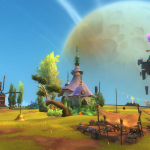
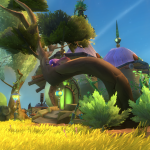
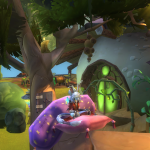
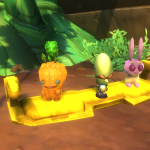
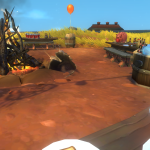
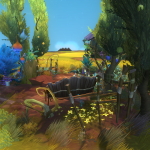
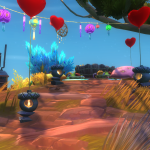
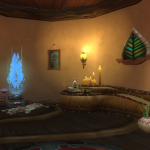
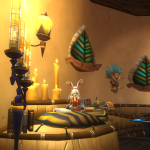

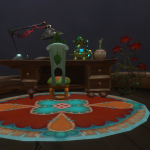
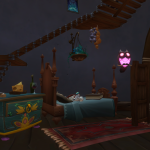
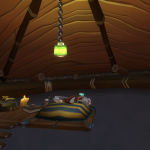
And then? I visited Steven and Perry’s houses. (Neither of them have sat down and FOCUSED on anything yet, it’s just always fun to stop and visit their random homes)
(Also, Steven’s is the one with the eyeball. Everything else is Perry shaking his pockets out as he wanders his property, as far as I can tell.)
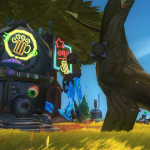
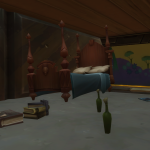
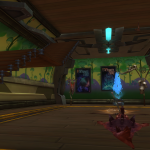
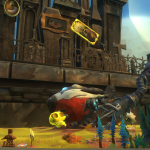
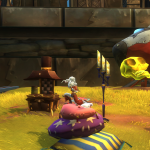
Related posts:
[Perry] Wildstar Wednesday
And Then We Bought a House
Blog Outage Incoming
June 13, 2014
[Steven] – Optimal Wordplay
If I were an person that looked on the bright side, I could be an optimist.
If my profession was to inspect the ocular cavity of my fellow beings, I could be an optometrist optimist.
If it were not mandatory to see me, I could be an optional optometrist optimist.
If I were really good at my profession, I could be the optimal, optional optometrist optimist.
If I were also a robot that was the leader of his race, I could be Optimus the optimal, optional optometrist optimist.
If you choose be, then you would have opted for Optimus the optimal, optional optometrist optimist!
You could have opted to be operated on by Optimus the optimal, optional, optometrist optimist
I would obviously do my best, therefore I would optimize the operation you opted for when you chose Optimus the optimal, optional optometrist optimist!
Related posts:
[Steven] Eager Wordplay
Catnip Stupor
TV Show Dissection : White Collar
June 12, 2014
UI vs UX and Why You Should Care
 (or at least, why you MIGHT care)
(or at least, why you MIGHT care)
Some Definitions
UI – User Interface. The thing that says forms get a submit button so that people can submit them.
UX – User Experience. The thing that agonizes over whether or not the submit button should have active phrasing such as “Get Your Free Copy of Tami’s Book Now” instead of just “Submit” and whether or not we should just hide the form fields you might not be required to enter until it becomes obvious that you WILL need to enter them (If you don’t select “yes, sign me up for your newsletter”, then don’t bother showing the email address field) and whether or not maybe the form is long enough that it should be broken down, and oh, by the way, shouldn’t the font size be a lot bigger when on mobile? Buttons, too. And oh, dear, you’ve hidden important information behind a hover effect, and that means …
Everything has a UI
Okay, that’s simplistic and a little unfair to pure UI, but you get the idea. Everything has a UI, but not everything takes the user experience into account. And I do mean “thing” there. Though I primarily focus on websites, I’m sure we’ve all had that one weird thing happen in the car and we stare at the dashboard in frustration and wonder just who the hell thought THAT was a helpful indicator of what the problem was.
Everything has a user interface. It’s just that there’s an awful lot of BAD ones out there.
Me
So, within the past mmmm year or so, I’ve gone from being officially a programmer to officially a hybrid of programming/UI/UX.
I’m much happier in my current role because I genuinely love the fact that almost my entire job is making something easier for other people.
I’m not about to pretend I’m even close to the kind of helpful a soup kitchen would be, but the entire purpose for my job is to solve problems and help.
So this whole UX/UI stuff is really incredibly stupidly fascinating to me. And I want to share some of the fun details with you guys as I’m learning them.
The Web
The internet isn’t standing still, not by a long shot. AS WE SPEAK, folks are swapping from primarily using desktop computers for web access to mobile devices.
My husband has a laptop — very mobile, always nearby. He still does most of his internet browsing on the iPad. It’s not that he’s lazy, it’s just that the iPad was MEANT to be mobile and the laptop is just CAPABLE of being mobile.
Google analytics is showing more and more business sites that the percentage of their viewership which comes from mobile devices is growing.
We cannot continue to code our websites in a rigid, unchanging framework expecting 1,000 pixels width. We can’t. Not forever, anyway.
Apps versus Websites
Many folks are turning to apps as their savior. The big businesses can afford to hire a team to develop an iOS app to augment or even replace the functionality of their site. This allows them to keep maintaining their old, inflexible codebase.
But then iOS changes. Oh, and now Andriod’s staring with robot-like patience at you, because guess what? Apple’s not the only big dog in this fight. (Windows phones? I’m sorry. You don’t count yet.)
And now you’ve got not one but THREE code bases that need to be maintained separately, and bugs in each, and you need to updating your shipping algorithm in all of them, but the one guy who knew how to do that in the iOS app just quit, and …
takes a deep breath
Or? Or you can put on your big girl pants and learn how to write responsive websites. Most of the hard work has already been done by the pioneers of the design world. Frameworks exist. Media queries are no longer the ‘bleeding edge’ of anything.
You can design your website so that it works equally well for the user checking in while waiting in line at the grocery store as the person sitting down to their desktop after a long day at work.
There are benefits to both approaches, but I feel that the App approach really only works when you don’t also want a website with all (or even most of) the same functionality.
Why You Should(might) Care
This stuff? This is the kind of stuff defining YOUR internet. It’s YOUR experience that UX designers care so much about. It’s your attention and your dollars and your frustration and your joy when you use an interface that goes beyond functionality and transcends into a realm of FUN.
I think it’s fascinating that someone wants your experience with a form’s submit button to be a good one that they spend hours worrying over sizes and styles and verbiage.
And I figure some of you probably think that’s interesting as well, though perhaps more on the “wow, you folks is nutterbutters” level of popcorn-eating sideline amusement than I personally feel. (That, by the way? Is how I feel when Brad-O and Anne get into philosophical arguments. I just grab a tub of popcorn and enjoy the show, even if I don’t understand everything that’s happening.)
Your Opinions
You’ve been living through these chaotic internet changes, though probably not reading websites on usability and books on UX design.
What have YOU noticed as trends in the websites that you use? What’s been changing in the way you interact with the internet? What do you like and what’s frustrating as a turtle in a bathtub?
Related posts:
The Birth of a Website – Part 1
Taven Moore's Blog
- Taven Moore's profile
- 5 followers



